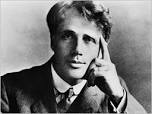Explaining the Symbolism of Being on the Road and Then Compare the Travels of Your Characters.
Robert Frost is arguably ane of the virtually well-known American poets of all time, so information technology'south non surprising that his work is taught in high schools and colleges across the nation. Because he'due south then famous, chances are you lot've encountered "The Road Not Taken" before. Nosotros're here to help you build a deeper understanding of "The Road Non Taken." To help you learn what Frost's "The Road Not Taken" poem is all near, we'll cover the following in this article: There'due south a lot to talk about, and then let'due south become going! Robert Frost is widely recognized every bit 1 of the most influential American poets of the 20th century. (Sneha Raushan/Wikimedia) Robert Frost was born in 1874 in San Francisco, California. His father was a newspaper editor (a profession Frost subsequently proficient himself, amidst others), and his mother was a teacher and Scottish immigrant. When he was about ten years former, his family moved to Massachusetts to exist about his grandfather, who endemic a sawmill. Frost was named both the valedictorian and the "class poet" of his loftier schoolhouse graduating class...and two years later published his kickoff verse form, "My Butterfly: An Elegy," in the New York Independent magazine. At this point, Frost knew he wanted to be a poet. Simply unfortunately, the next segment of Frost'due south life would be marked by upheaval. He attended both Dartmouth and Harvard, but dropped out of both earlier graduating. His poetry wasn't gaining traction in the The states, either. To complicate matters further, Frost and his wife, Elinor, suffered personal tragedy when ii of their vi children died in infancy. In 1900, feeling frustrated by his job prospects and a lack of traction in his poetry career, Frost moved his family to a subcontract left to him by his grandad in Derry, New Hampshire. Frost would alive at that place for nine years, and many of his most famous early poems were written before his morning time chores while tending to the subcontract. But Frost's poetry was still largely overlooked by American publishers. Consequently, Frost decided to sell the subcontract in 1911 and moved his family to London. Information technology was there he published his first anthology of poetry, A Male child's Will, in 1913. Frost's second album, North of Boston, was published in 1914 and found massive success in England. Finally, after years of struggle, Frost became a famous poet essentially overnight. In order to avoid WWI, Frost returned to the U.S. in 1915 and began education at Amherst College and the University of Michigan, all the while continuing to write poesy. He received numerous awards and recognitions, including the Pulitzer Prize for poesy, and became the public face of 20th century American poetry. Late in life, at 86 years former, Robert Frost also became the get-go inaugural poet at John F. Kennedy's inauguration in 1960. Throughout his career, Frost never strayed far from sometime-fashioned, pastoral poetry, despite the fact that newer American poets moved in a more experimental direction. Frost's verse continued to focus on rural New England life up until his expiry in 1963. "The Road Not Taken" is a narrative poem, pregnant it is a verse form that tells a story. It was written in 1915 every bit a joke for Frost'southward friend, Edward Thomas. Frost and Thomas were fond of hiking together, and Thomas often had trouble making upward his mind which trail they should follow. (Aye, that'due south right: ane of the most famous American poems was originally written as a goofy individual joke between ii friends!) Frost kickoff read it to some college students who, to his surprise, thought information technology a very serious verse form. "The Road Non Taken" was first published in the August 1915 issue of The Atlantic Monthly , then was re-published as the opening poem in his poetry collection Mountain Interval the next year. The full text of the poem is below. 2 roads diverged in a yellow woods, And so took the other, as but equally fair, And both that morning every bit lay I shall exist telling this with a sigh Frost'south most famous verse form got its start as part of a letter of the alphabet sent to his best friend on the eve of World State of war I. "The Road Not Taken" has become well known for its perceived encouragement to take the "[road] less traveled past." In other words, many people interpret this poem as a call to blaze new trails and pause away from the status quo. This is partly why lots of people misremember the poem's championship as "The Road Less Travelled." This estimation of "The Route Not Taken" is debatable (more than on that later), simply it was enough to inspire Frost'south friend Edward Thomas to brand a very grave decision to fight in World State of war I. Frost and Thomas were great friends while Frost lived in England, both of them were well-read and very interested in nature. They oftentimes took long walks together, observing nature in the English countryside. Nevertheless, Frost's fourth dimension in England ended in 1915 when Globe War I was on the verge of breaking out. He returned to the Us to avoid the war and fully expected Thomas to follow him. Thomas did not. Frost's poem came in the mail as Thomas was deciding whether to exit Europe or to participate in the war effort. While "The Road Not Taken" wasn't the only matter that made Thomas enlist and fight in Globe War I, it was a factor in his determination. Thomas, regretting his lack of achievement compared to his good friend Frost and feeling that the verse form mocked his indecisiveness, decided to accept initiative and fight for his country. Unfortunately, Thomas was killed at the Boxing of Arras on April 9, 1917. Thomas was inspired to take "the road not taken" because of Frost'south verse form. The same is true for many people who've read the poem since it was first published in 1915. The concept of taking a "route less traveled'' seems to advocate for individuality and perseverance, both of which are considered central to American culture. The verse form has been republished thousands upon thousands of times and has inspired everything from self-assistance books to car commercials. To aid yous understand the significance of Robert Frost'southward poetry, we'll suspension down the overall meaning and major themes of the poem in our "The Route Not Taken" analysis beneath. Merely earlier we do, go back and reread the poem. Once you accept that done, come up back here...and nosotros can go started! "The Road Not Taken" is a poem that argues for the importance of our choices, both big and small, since they shape our journey through life. For Frost, the most important decisions we make aren't the ones we spend tons of time thinking nigh, like who we have relationships with, where we go to college, or what our future career should exist. Instead, Frost'south verse form posits that the small choices nosotros make each and every 24-hour interval also take big impacts on our lives. Each conclusion we make sets us upon a path that we may not understand the importance of until much, much later. This theme is reflected throughout the poem. For example, the poem begins with a speaker placing us in a scene, specifically at the point where ii roads interruption away from each other in the eye of a "yellow wood." The speaker is sorry they cannot get both directions and yet "be one traveler," which is to say that they cannot live 2 divergent lives and notwithstanding exist one single person. In other words, the speaker can't "have their cake and consume it, also." The speaker has to choose one direction to go down, because like in life, making a determination often means that other doors are subsequently shut for you. For example, if yous choose to go to college at UCLA, that means you lot're as well choosing not to go to college elsewhere. Yous'll never know what it would exist like to go to the Academy of Michigan or as a freshman straight out of high school because you fabricated a dissimilar choice. But this is true for smaller, day-to-day decisions as well. Choosing who y'all spend time with, how hard you written report, and what hobbies your pursue are examples of smaller choices that as well shape your future, too. The speaker of the verse form understands that . They stand at the crossroads of these 2 paths for a long time, contemplating their selection. Starting time, they stare downward ane path as far as he or she tin can, to where it trails off into the undergrowth. The speaker then decides to accept the other path, which they state is simply equally "off-white," meaning just as attractive as the showtime. The narrator states that the 2d path "wanted clothing," meaning that information technology was slightly more overgrown than the offset path. But more importantly, no matter which path the speaker takes, they know they're committed to follow it wherever information technology may lead. Nosotros see that in this stanza: And both that morn equally lay While the speaker says they "saved the get-go" path for "another mean solar day" to make them feel better about their decision, the next ii lines show that the speaker realizes they probably won't be able to double back and accept the first path, no matter where the second one leads. Just similar in life, each path leads to some other path, and then some other. In other words, the decisions we make in the moment add together up and influence where nosotros end up in life--and we don't actually go a "redo" on. After choosing their path, the speaker says they expect forward to a twenty-four hours far in the future when, "with a sigh," they'll tell people well-nigh taking the road "less traveled past,/And that has made all the departure." Does this mean that taking the ane less traveled has "made all the divergence" in a good way? Saying so "with a sigh" doesn't necessarily sound similar a good thing. The poem isn't at all clear on whether or not taking the less traveled path was a skilful choice or a bad choice. So while the poem is articulate that all of our choices shape the path we take in life, information technology's more cryptic almost whether choosing "less traveled" paths is a good thing or not. That's upwardly to readers to decide! This brings the states to our commencement theme: how hindsight gives our choices power. The speaker begins at a point of bifurcation (which is a fancy way of proverb "break into 2 branches"). Every bit readers, nosotros're meant to accept the poem both as a literal story about someone in the woods trying to decide which way to go, likewise as a metaphor about how our life choices are like divergent paths in the woods. Like we mentioned earlier, the poem is clear that y'all can't take ii paths and still "be one traveler," nor can you exist certain that you'll ever become a chance to test out your other options. That's because every selection you make leads to more choices, all of which atomic number 82 you further and further from our starting point. However, the poem also suggests that while the choices we make are important, how we translate these choices is what actually makes us who nosotros are. We see this in the last lines of the verse form, which read: I took the one less traveled by, Essentially, the speaker is proverb that later in life he will look back in time and run into that moment as 1 of great significance. But nosotros can only know which choices matter the virtually through the power of retrospection. Information technology'southward similar the erstwhile maxim goes: hindsight is 20/20! Here's what frost means: when we're making choices in life, they might seem inconsequential or like they're not that big of a deal. But one time time passes and we've journeyed down our path a little farther, we can look back into the by and see which choices have shaped u.s.a. the virtually. And oft, those choices aren't the ones we think are near important in the moment. The clarity and wisdom of hindsight allows us to realize that doing something like taking the path "less traveled by" has impacted our lives immensely. "The Road Not Taken" is as well about our perspective...and how hindsight helps usa reconsider our past conclusion. The other major theme in "The Route Not Taken" is how our private perspective. The speaker of the poem spends most of their fourth dimension trying to decide which path to have. They describe each path in item: the first one curves into the undergrowth, while the second was more tempting because it was "grassy" and a piddling less worn. But the truth is that these paths have more than in common than not. They're both in the woods, for one. But the speaker also says the first is "just as fair" as the other, significant it'south just as pretty or bonny. They as well mention that "And both that morning as lay / In leaves no step had trodden black," which is a poetic way of maxim that neither path had been walked on in a while. And even the one the poet says is less traveled was really "worn...about the aforementioned" equally the start path! And so it's the speaker'southward perspective that makes these paths seem divergent rather than them actually beingness super different from ane some other! Considering our perspectives shape the style we sympathise the world, it also affects our memories. Our memories help us understand who we are, and they shape the person nosotros become. But equally we tell ourselves our own story, nosotros overwrite our memories. Information technology'southward kind of like deleting a judgement and retyping it...only for information technology to modify a little bit each fourth dimension! What is your primeval memory? What is your favorite memory? Now think about this: are yous remembering them, or are you lot remembering remembering them? Is at that place a divergence? Aye, because science shows that every unmarried fourth dimension we think a memory we change information technology. It'south very possible that your favorite early memory isn't your memory at all--information technology is more probable a memory of existence told something that happened to you lot. Perhaps you have a photo of a moment that triggers your memory. The photograph may non change, but yous practise and your retentivity of the things that happened in that moment practise. And so, if our experiences and our choices make the states who we are, but we're constantly misremembering and changing our memories, how do actual events even matter? "The Route Not Taken" says that they do. Our choices we brand are impactful, merely the style we remember them is what helps shape the states equally individuals. And then "The Road Not Taken" isn't necessarily an ode to bravely taking the less popular path when others wouldn't. It'south more like an ode to being resigned to believing our choices fabricated u.s.a. who we are, even though if nosotros hadn't made them, hadn't taken that path, we'd exist someone else who made choices that were simply equally valid. Poetic devices are the tools nosotros can use to unpack the meaning of a poem. Here are ii that are important to understanding "The Road Not Taken." Poetic devices are literary devices that poets apply to enhance and create a poem's structure, tone, rhythm, and meaning. In Robert Frost's, "The Route Non Taken," Frost uses iambic meter and vox to reinforce the poem's meaning. First affair'southward showtime: the post-obit is simply a brusk overview of iambic meter. If you want an in-depth discussion of meter, check out our weblog about it. Then what is meter? The English language language has well-nigh an equal number of stressed and unstressed syllables. Arranging these stressed syllables into consistent is one of the most common means of giving a verse form a structure...and this organization is called "meter." A poem's meter is fabricated up of units. Each "unit of measurement" of stressed and unstressed syllables that repeats in a poem is called a foot. A pes can either be an iamb (one unstressed followed by i stressed syllable), a trochee (one stressed syllable followed by an unstressed syllable), a dactyl (one stressed syllable followed by ii unstressed syllables) or an anapest (2 unstressed syllables followed by a stressed syllable). The iamb is the foot that comes to us most naturally as native English language speakers, and the most iambs nosotros tin can speak easily without having to inhale for another breath is near five. And so the most common structure for English linguistic communication poetry is iambic pentameter, significant the almost common pes is an iamb, and at that place are five iambs per line. Historically, the vast majority of verse written in English has been in iambic pentameter, and information technology was the default format for English language poetry for centuries. Merely pentameter isn't the only iambic meter: 2 anxiety make dimeter, three feet brand trimeter, four feet brand tetrameter, and six anxiety make hexameter, and and so along. The Modernist poets started moving away from these traditional repeating patterns of meter just later Globe War I, using invented patterns called "costless poesy." Although Modernist gratis verse didn't supplant metrical poesy overnight or completely, it slowly broke downward the central importance of it in ways that are notwithstanding felt today. Robert Frost's "The Road Not Taken" is from the very tail end of the iambic-meter-every bit-a-necessity era. Frost stubbornly and famously stuck to the traditional metrical forms, comparing free poesy to playing tennis "with the net down." Information technology is the iambic meter that gives the poem its "old-fashioned" rhythm and comfortable feeling. It's also the matter that makes the verse form sound so natural when you read it out loud. You may not fifty-fifty immediately recognize that the poem is in iambic meter, merely information technology becomes clear when y'all start breaking downwards the lines. Take this one, for case: Two roads diverged in a yellow wood, Looking at the stressed and unstressed syllables we get: two ROADS/di-VERGED/in a YELL/ow Woods The capitalized syllables are stressed, and the lowercase ones aren't. Each pair of these is an iamb! At that place are 4 stressed syllables on this line, too as every other line in the poem. That means this poem is in iambic tetrameter. The most mutual human foot is an iamb (although notice that the third foot is an anapest), and there are four of them. So why is this important? First, iambic tetrameter is a metrical pattern favored by the 19th century Romantics, who very frequently wrote poems that involved solitary people having great epiphanies while out in nature by themselves. Past mimicking that manner, Frost pulls on a long poetic tradition helps readers hone in on some of the major themes of his verse form--specifically, that the speaker's decision in the woods will have long-term consequences for both their character and their life. The iambic class also rolls off of the tongue easily because it'south the most common meter in the English language. That also echoes the importance of nature in "The Route Non Taken": both in terms of the natural imagery in the poem, simply too in its word of the nature of perspective and retentiveness. In that way, the course of the poem helps to reinforce its themes! The second poetic device that Frost employs is vocalisation. The vocalisation of a poem is the product of all the stylistic and vocabulary choices that add together upwardly to create a character. In this instance, the poem has one grapheme: the speaker. The speaker is unnamed, and it's through their perspective that we experience the poem. It'south easy to think of the speaker every bit being Frost himself, but try to resist that temptation. The vox of a poem is an artificial construct, a graphic symbol created to requite the poem a certain effect. So how does Frost create this voice? Starting time, note that the verse form is in first person . That means we're getting the speaker'southward perspective in their own words, signaled past their apply of first person pronouns like "I." Additionally, the audience isn't being addressed direct (similar in Maya Angelou's "Even so I Rise). Instead, it'due south as if we've intruded upon the speaker's thoughts equally they ruminate over the potential ramifications of choosing 1 path over another. Writing the poem in start person means that we're getting the story straight from the horse's mouth. In some ways, this is a skilful affair: it helps us understand the speaker'south unique perspective and in their own unique voice. But in other ways, it makes the objective details of the moment less articulate. That'south considering the speaker'southward recounting of the moment in the woods is colored by his own retentiveness. That means we have to rely on the speaker'south estimation of events...and decide how that impacts our estimation of the poem! The first person narration too gives the poem much of its cogitating nature. Analyzing poesy tin can be tricky, so it's helpful to read a few expert analyses. We have a agglomeration on our web log that you can read through, similar this one about Dylan Thomas' "Do not get gentle into that proficient night" or this article that explains 10 different sonnets! It's much easier to analyze poetry when yous have the correct tools to do it! Don't miss our in-depth guides to poetic devices like assonance, iambic pentameter, and allusion. If you're more near writing poesy than analyzing information technology, we've got you covered! Here are 5 swell tips for writing poetry (and a few scholarships for budding poets, besides).
Robert Frost Biography
Robert Frost, "The Road Not Taken" Poem
"The Road Not Taken" by Robert Frost
And sorry I could not travel both
And exist one traveler, long I stood
And looked downwards 1 as far every bit I could
To where it bent in the undergrowth;
And having perhaps the better merits,
Because it was grassy and wanted wear;
Though as for that the passing there
Had worn them really about the same,
In leaves no footstep had trodden blackness.
Oh, I kept the first for another twenty-four hours!
Yet knowing how way leads on to way,
I doubted if I should ever come dorsum.
Somewhere ages and ages hence:
Ii roads diverged in a wood, and I—
I took the ane less traveled by,
And that has made all the deviation.
The Background Behind "The Road Non Taken" Poem

Robert Frost "The Road Not Taken" Assay: Meaning and Themes
Robert Frost "The Road Non Taken" Meaning
In leaves no step had trodden black.
Oh, I kept the first for another day!
Withal knowing how fashion leads on to manner,
I doubted if I should always come up back. Robert Frost "The Road Non Taken" Theme 1: The Power of Hindsight
And that has made all the deviation.
Robert Frost "The Road Not Taken" Theme 2: Perspective and Memory

The Top 2 Poetic Devices in "The Route Not Taken"
Poetic Device 1: Iambic Meter

Poetic Device 2: Voice

What's Next?

About the Author
Ashley Sufflé Robinson has a Ph.D. in 19th Century English language Literature. As a content author for PrepScholar, Ashley is passionate about giving college-jump students the in-depth information they demand to become into the school of their dreams.

0 Response to "Explaining the Symbolism of Being on the Road and Then Compare the Travels of Your Characters."
Post a Comment